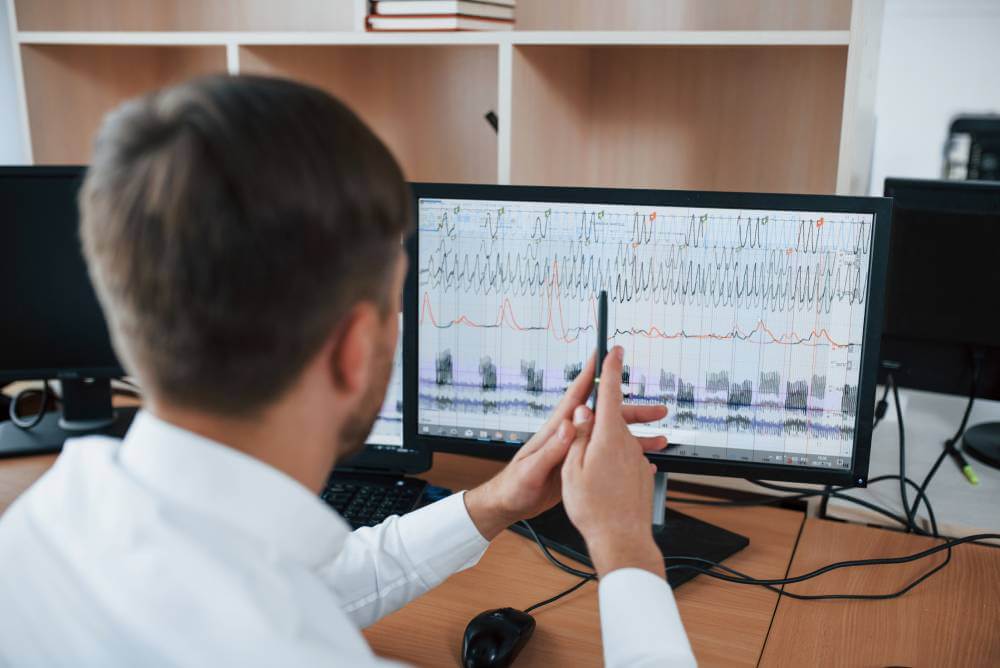There are several ways to characterize high-speed digital channels, all aimed at verifying specific signal integrity metrics that demonstrate channel compliance. While tools like S-parameters and impedance are valuable, one key measurement that must be assessed with a digital bitstream is the eye diagram.
An eye diagram is an essential measurement or simulation tool used in evaluating channel compliance. It visually represents various factors that can impact signal behavior simultaneously, providing insights into potential errors and losses within a channel. In this article, I’ll discuss some fundamental measurements that can be manually extracted from an eye diagram and how these insights can inform strategies for enhancing channel designs.
Eye Diagrams in Signal Integrity Analysis
What is an Eye Diagram?
An eye diagram is a crucial measurement used to evaluate channel designs in digital systems. It involves superimposing a bitstream’s rising and falling edges in a time-domain sampling trace, often utilizing an oscilloscope. This technique can also be performed by a signal integrity simulator, which overlays the signal levels. By visually combining these rising and falling edges, engineers can clearly assess the variability in signal behavior.
The primary purpose of analyzing eye diagrams is to identify variances that may contribute to bit error rates. When signal traces are overlaid, it’s possible to gather statistical data at various points along the time-domain measurements, allowing for a detailed analysis of signal integrity. This can reveal critical information about the quality of the signal, including aspects like jitter, noise, and distortion.
Applications of Eye Diagrams
Eye diagrams are instrumental in various stages of product development, including:
Design Verification: Engineers use eye diagrams during the design phase to validate that the channel can support the required data rates without excessive errors. This can help identify issues early, allowing for design modifications before production.
Testing and Compliance: In compliance testing, eye diagrams are used to ensure that digital systems meet industry standards for signal integrity. Compliance testing can involve comparing measured eye diagrams against specifications set by standards organizations.
Troubleshooting: When signal integrity issues arise in a deployed system, eye diagrams can assist in diagnosing the root cause. By analyzing the eye diagram of a malfunctioning signal, engineers can identify problems related to jitter, noise, or improper termination.
What You Can Learn From an Eye Diagram
An eye diagram provides a comprehensive overview of a digital signal’s performance, allowing engineers to extract valuable insights from a single measurement. Here are some critical parameters you can evaluate directly from an eye diagram:
1. Timing Jitter
Timing jitter reflects the variability in the rise and fall transitions of the signal. By observing the signal crossings during switching in the eye diagram, you can quantify this jitter. It accounts for both random noise and timing skew in differential pairs, highlighting how fluctuations can affect the timing of signal transitions. Understanding jitter is essential for maintaining signal integrity, especially in high-speed communications.
2. Signal Level Variance
The eye diagram makes it easy to visualize how the signal levels vary over time. This variance is typically a function of timing jitter combined with other random noise influences. Additionally, variations can stem from impedance mismatches in the channel, which can cause reflections and distortions. Analyzing this variance helps identify potential issues in the channel design and allows for corrective measures to be implemented.
3. Average Rise/Fall Time
The average rise and fall times can be derived from the eye diagram by measuring the time it takes for the signal to transition from 10% to 90% of its maximum value. These metrics are indicative of the channel’s response and can reveal the presence of noise and reflections. If the rise or fall times exhibit significant plateaus or irregularities, it may indicate problems such as strong reflections or inter-symbol interference (ISI), which can degrade overall performance.
4. Average Symbol Duration
Average symbol duration is determined by measuring the time between the midpoints of consecutive signal crossings. This measurement is crucial for understanding how quickly the signal can convey information. A longer symbol duration can suggest a slower data rate, while a shorter duration indicates higher speeds. Evaluating this parameter helps assess whether the system meets its intended data throughput.
5. Bit Error Rate (BER)
The eye diagram is instrumental in determining the bit error rate (BER) by comparing the logic thresholds with the received bits. This metric reflects the reliability of the signal and is critical for assessing overall system performance. A desirable BER can be as low as \(10^{-12}\) or lower, indicating a highly reliable system. Techniques such as equalization and pre-emphasis can help reduce BER values. For example, dynamic feedback equalization (DFE) is commonly used in high-speed applications like 400G with PAM-4 signaling to improve signal integrity and minimize errors.
Intersymbol Interference

Intersymbol interference (ISI) is a phenomenon where successive signals interfere with each other, often resulting from signal integrity issues in a digital communication channel. This interference can distort the received signal, making it challenging to interpret the data being transmitted accurately. By analyzing ISI in the context of an eye diagram, engineers can identify specific problems affecting the performance of a digital channel.
Understanding Intersymbol Interference
ISI occurs when the effects of one bit spill over into the period of subsequent bits, causing confusion in signal interpretation. This can happen due to various factors, such as bandwidth limitations, reflections, and improper termination, which can alter the shape of the transmitted signals. As a result, the receiver may misinterpret the incoming signals, leading to increased error rates.
Identifying ISI Through Eye Diagrams
Eye diagrams are invaluable tools for visualizing ISI and other signal integrity problems. When you observe an eye diagram, the clarity of the “eye” opening provides insight into the signal’s performance. A well-defined eye-opening indicates minimal ISI, while a closed or distorted eye suggests significant interference.
Jason Ellison highlights that the ISI observed in a channel is a cumulative metric. By examining the eye diagram, you can correlate ISI with other parameters, such as insertion loss deviation, which further aids in diagnosing the underlying issues affecting signal quality.
Ideal Eye Diagram Characteristics
This leads to the question of what constitutes an objectively desirable eye diagram. Ideally, you would aim for:
Zero Signal Distortion: The transmitted signals should remain unchanged as they pass through the channel.
Zero Jitter: There should be no variation in the timing of signal transitions.
Zero Pulse Spreading: The bits should maintain their shape without any spreading that might cause overlap with adjacent bits.
Zero Amplitude Noise: The signal levels should remain constant and clear, with no unwanted fluctuations.
In essence, the output signals should perfectly match the input signals, demonstrating the system’s ability to transmit data without interference or loss of integrity.
How to Read an Eye Diagram
Reading an eye diagram is essential for understanding the performance of high-speed digital channels. The eye diagram visually represents the timing and voltage levels of signal transitions, allowing you to evaluate the quality of the signal as it travels through the channel. Here’s a breakdown of how to interpret an eye diagram effectively.
Key Components of an Eye Diagram
Eye Opening
The most critical feature of an eye diagram is the “eye-opening,” which refers to the space where the signal is clear and distinct. A larger eye opening indicates a healthier signal with lower noise and better signal integrity, while a smaller opening suggests potential issues.
Mask
The mask is an overlaid shape that defines the acceptable limits for the signal. If the eye diagram’s traces fall outside this mask, it indicates that the signal is violating acceptable parameters, which could lead to data errors.
Vertical and Horizontal Scale
The vertical axis represents voltage levels, while the horizontal axis represents time. The position of the signal traces within these axes provides insights into timing jitter and signal amplitude.
Measuring and Simulating Eye Diagrams and BER

Eye diagrams are a powerful tool for assessing the performance of high-speed digital channels. They can be generated through both simulation and measurement, providing insights into signal integrity and compliance.
Simulating Eye Diagrams
Channel Models
Eye diagrams can be simulated using a channel model that includes known S-parameters or transfer functions. This approach allows for evaluating signal integrity before physical prototypes are built.
A pseudorandom bit sequence can be used to create the eye diagram through a convolution operation, effectively modeling how the signal will behave in the actual channel.
Tools for Simulation
Mathematical scripting programs like MATLAB are often used for this purpose. These tools can efficiently handle the calculations required for simulating eye diagrams based on channel characteristics.
PCB Layout Considerations
Simulations can also be performed directly from a PCB layout, considering parasitic elements such as capacitance and inductance. This helps in predicting real-world performance more accurately.
Measuring Eye Diagrams and BER
Prototype Testing
Once a prototype is developed, the primary objective shifts to determining channel compliance and extracting a channel model from physical measurements. This step is critical for validating the design and ensuring it meets the required specifications.
Compliance Testing
Measuring the eye diagram in a prototype allows you to evaluate signal integrity and compliance with industry standards. Key metrics such as eye-opening, timing jitter, and signal level variance can be assessed.
Analyzing Bit Error Rate (BER)
Analyzing BER can be complex, often requiring additional testing setups and detailed evaluation of the signal quality over time. For a deeper understanding of BER analysis, refer to resources like the article from Tektronix.
Additional Measurements
Beyond the basic eye diagram analysis, other measurements can provide further insights into channel performance. Keysight’s support articles offer guidance on various metrics you can extract from eye diagrams, helping you build a comprehensive view of your design’s integrity.
Practical Application in PCB Design
When it comes to placing components, routing transmission lines, and ensuring signal integrity, utilizing a complete set of PCB design tools is essential. These tools not only facilitate the design process but also integrate simulation capabilities that help you predict and validate the performance of your digital systems.
By leveraging both simulation and measurement techniques for eye diagrams and BER analysis, you can enhance your design’s reliability and ensure that it meets the rigorous demands of high-speed digital communication.
